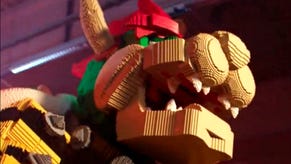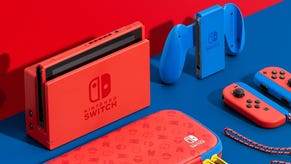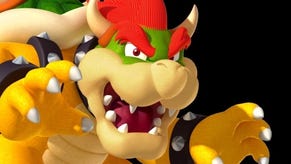Super Mario 3D World + Bowser's Fury tech analysis: classic port meets experimental showcase
Franchise past and future?
First released back in 2013 on Wii U, one of the ill-fated platform's greatest games has transitioned across gracefully to Nintendo Switch. Offering a perfect mix of 2D and 3D Mario design concepts, Super Mario 3D World gets a new lease of life on the console hybrid, not least because of the inclusion of an all-new game - Bowser's Fury. Here, we see Nintendo try out some new, unexpected ideas that feel remarkably fresh - and it's impressive enough to stand alone as its own game.
I'll always have a place in my heart for Super Mario 3D World: it mixes full 3D movement and exploration with a more linear stage design. The player has limited camera control and progression is very much rooted in old school design, but it still feels like a 3D Mario game. Even the world map, clearly inspired by the style of design introduced in Super Mario Bros 3, takes on a new twist with free movement. It's a classic game, but Nintendo hasn't been afraid to makes tweaks and changes to improve the experience. Specifically, movement speed is boosted significantly, resulting in a faster playing game all around. Touchscreen mechanics are also tweaked - a core feature on Wii U simply wouldn't work outside of portable mode on Switch, so Nintendo has added cursor control using the built-in gyroscope to allow you to manipulate the environment in the relevant stages. I can say it works well enough given the constraints, but I do prefer using touch for these specific stages.
Technologically, the game is essentially identical to its Wii U outing, with identical assets, bolstered only by a mild boost to resolution. The Switch game uses dynamic resolution scaling with an apparent 720p to 1080p window, up against the straight 720p of the Wii U original. Portable mode maps to the native resolution of the screen, so it's native 720p. With that said though, I do think Nintendo has introduced some form of interlace style image reconstruction - a curious flicker presents that simply isn't there on the Wii U version. This odd flicker isn't really distracting, but it is certainly unexpected and suggests that just running the game at a higher native resolution might have been off the table. Regardless, the presentation is sharper overall. It should be noted that Nintendo deployed something similar with Super Mario Odyssey when played in portable mode - but it was vertically orientated. Performance? It's locked in both docked and portable modes at 60fps.
So far, so good. Aside from the resolution quirks, this is pretty much the Wii U game translated successfully to Switch, but Bowser's Fury is a radical departure from the template set by 3D World. It is, effectively, a model for a potential new style of 3D Mario game. Rather than breaking play up into stages or areas, Bowser's Fury presents the player with a series of islands and structures. Bowser's Fury presents a theory on what a 3D Mario game might look like if all of the stages were included within a shared map, so rather than jumping through a painting or flying to another planet, the levels are accessed seamlessly.
This is where Bowser comes in- as you play, a storm approaches at certain points and the music changes. At this point, the sky goes dark and Bowser emerges. As small Mario, all you can do is avoid his wrath and/or use his attacks to uncover otherwise blocked routes. However, collect enough Cat Shines, and you gain access to a giant bell that allows Mario to match Bowser's new size. This results in a series of battles that changes the scale of the stage in a way akin to Katamari Damacy's presentation. As you progress, more of the world becomes available allowing you to find new stages within.
It's a neat idea and it works brilliantly but I feel it also pushes the Switch hardware to its limits. The world is surprisingly large and detailed: each island is packed with visual flourishes while effects such as rain, blasts of fire or even the screen-space reflections used on the water help to flesh out the experience. Unlike 3D World, you also have full camera control with the right stick. This, combined with the design of the world itself, means that it's a very different - and more like a proper 3D Mario sequel.
Of course, the sacrifices are clear compared to 3D World. The resolution is reduced from near 1080p to usually hanging between 720p and 792p in docked mode. Image quality is basically comparable to Super Mario Odyssey, which isn't necessarily a bad thing, but the increased draw distance and scope of the environment does reveal these flaws more easily. More interestingly, Bowser's Fury does not seem to use the reconstruction mode featured in 3D World, so the slight flicker in that game is not present here.

But performance in Bowser's Fury is where things get tricky: docked mode targets 60 frames per second, feeling mostly smooth but not quite perfect, with some momentary slowdown and what seems to be some minor hiccups from background asset streaming. When considering the lower resolution and momentary frame-rate drops, it certainly seems like this new open concept is pushing the Switch pretty hard and building upon these ideas might require a little more grunt. Still, by and large, performance is perfectly fine and impressive given what's going on here - but what surprised me the most only becomes visible in portable mode. The reason for the higher rendering resolution comes down to frame-rate, with portable mode capped at 30 frames per second. This is the same frame-rate as Mario 3D Land on 3DS and various other 3D titles so it's not necessarily a huge issue for this title but it is jarring to move from docked to portable mode in this case, and it's the first time we've seen such an obvious divide on a Nintendo first-party title. Furthermore, while it's mostly stable, busier moments also exhibit frame-pacing issues which is more surprising.
This is one of the rare times we've seen Nintendo take the approach of favouring image quality over performance in mobile mode - the plus point to this situation is that you are still getting a crisp 720p resolution on the go. It's worth stressing though that the 60fps/30fps divide applies to Bowser's Fury only: Super Mario 3D world is a properly locked full frame-rate on both docked and mobile modes.
Ultimately, Super Mario 3D World itself is a solid port to from Wii U to Switch and the concessions made to image quality are fascinating to consider as well. Clearly the game is slightly more demanding than, say, Mario Kart 8 which delivers a native 1080p experience instead. Meanwhile, Bowser's Fury then is an interesting experiment that plays brilliantly while also pushing the Switch hard with its open-ended design.
Overall though, this is an excellent package. In my opinion, Super Mario 3D World remains one of the best polygonal Mario games ever made, and it looks and plays just as well today as it did back on Wii U. In fact, with the increased walking speed, it feels even better all around. Bowser's Fury is equally worth playing with some very cool new ideas that we haven't seen before in a Mario game. It perhaps hints at where the series could potentially go next and I love it - oh, and the soundtrack is just superb. This is the kind of release I really enjoy - it assembles everything that was great about the original and bundles it up with an entirely new game while offering a generally improved experience across the board. Put simply, it's well worth checking out.



.jpg?width=291&height=164&fit=crop&quality=80&format=jpg&auto=webp)














